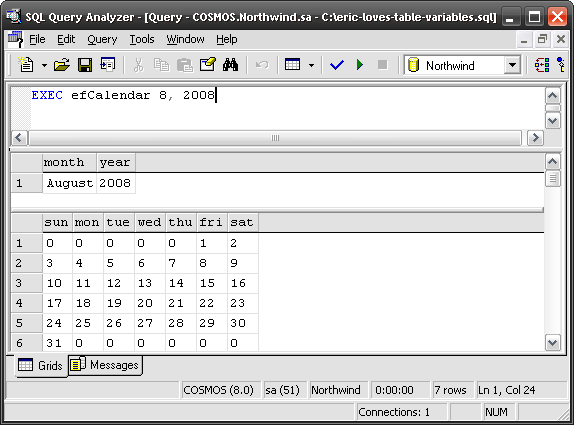Here’s a blast from the past that I recently found in my archives. It’s a novelty stored procedure I wrote during my MS SQL 2000 DBA days.
Back when I wrote this sproc, I was really big into writing calendar applications. I have written some sort of calendar application in
almost every language I know, so writing one in tSql made sense to me.
While I never used this sproc in an application, or had any practical use for it, I still think it’s cool. It’s primarily an excercise using
tSql’s date functions, and my all time favorite feature of MS SQL 2000+, table variables.
If you use MSSQL 2000 or higher and don’t use table variables, I highly recommend looking into these. In a nutshell, it’s a type of tSql variable
that is a table. You can select, insert, update, and delete the rows in this variable just like it’s a real table. The lifespan of a table variable
is the length of your connection to your db. So if you have a table var #myTable in sprocA, as soon as sprocA completes execution, #myTable is gone.
SprocB can’t access #myTable unless is specifically creates a new table var by this name.
So I wrote an article about this sproc for a database site years ago and I haven’t been able to find it again. This was web1.0 days, so I’m sure the site
is gone by now. The good thing is I still have the sproc, and now you can to.
So here’s the info. The sproc efCalendar accepts a month number and year number, and spits out two recordsets.
- Month, Year
- Calendar view of that month
Recordset 1 is two columns, month name, and year.
Recordset 2 is a calendar view of the specified month. There is a column for each weekday, starting with Sunday and ending with Saturday.
Then there is a row for each week in the specified month.
Here is what the results look like when run in Query Analyzer.

